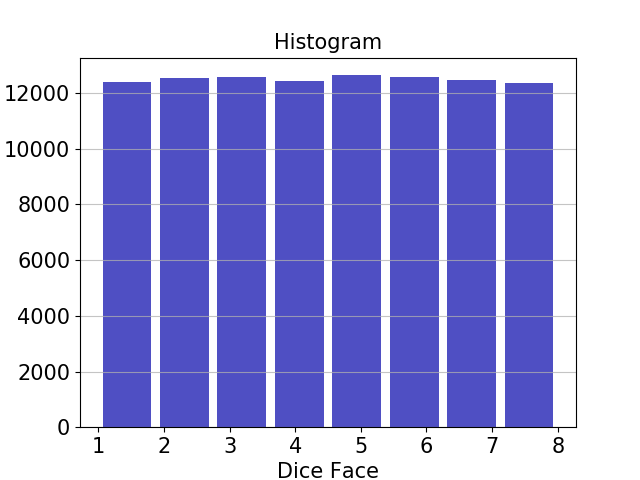QX Simulation¶
This tutorial explains how to compile an OpenQL program and execute it on QX. We will use the example of rolling an 8-faced dice. Rolling this dice results in 1 out of 8 outcomes. The complete code for this example is available in examples/dice.py
OpenQL Program¶
We start by importing openql, qxelerator and some python packages. We also set some options for openql. For this example we will be using 3 qubits. All this is done by the following code snippet:
from openql import openql as ql
import qxelarator
from functools import reduce
import os
import matplotlib.pyplot as plt
curdir = os.path.dirname(__file__)
output_dir = os.path.join(curdir, 'test_output')
ql.set_option('output_dir', output_dir)
ql.set_option('write_qasm_files', 'yes')
ql.set_option('scheduler', 'ASAP')
ql.set_option('log_level', 'LOG_INFO')
nqubits = 3
Next we create a platform, a program and a kernel. We populate the kernel with 3 hadamard gates being applied on each qubits. This will put each qubit in superposition. Measuring each qubit will collapse the state resulting in getting either 0 or 1. This is done by dice_compile() as shown below:
def dice_compile():
print('compiling 8-face dice program by openql')
config = os.path.join(curdir, '../tests/hardware_config_qx.json')
platform = ql.Platform("myPlatform", config)
p = ql.Program('dice', platform, nqubits)
k = ql.Kernel('aKernel', platform, nqubits)
for q in range(nqubits):
k.gate('h', [q])
for q in range(nqubits):
k.gate('measure', [q])
p.add_kernel(k)
p.compile()
Compiling the above code snippet will produce the following quantum assembly code in cQASM v1.0 format:
- test_output/dice.qasm which is the generated un-scheduled qasm code
- test_output/dice_scheduled.qasm which is the generated qasm code after scheduling
For instance, dice.qasm contents are shown below:
version 1.0
# this file has been automatically generated by the OpenQL compiler please do not modify it manually.
qubits 3
.aKernel
h q[0]
h q[1]
h q[2]
measure q[0]
measure q[1]
measure q[2]
These cQASM codes can be simulated on QX simulator. For this we are using the simplified python interface to QX known as QXelarator. This is done by the following code snippet:
def dice_execute_singleshot():
print('executing 8-face dice program on qxelarator')
qx = qxelarator.QX()
# set the qasm to be executed
qx.set('test_output/dice.qasm')
# execute the qasm
qx.execute()
# get the measurement results
res = [int(qx.get_measurement_outcome(q)) for q in range(nqubits)]
# convert the measurement results from 3 qubits to dice face value
dice_face = reduce(lambda x, y: 2*x+y, res, 0) + 1
print('Dice face : {}'.format(dice_face))
Running dice.py will produce output as shown below:
Dice face : 2
where, the Dice face can be any number between 1 and 8.
Next we can also roll the dice 100000 times and plot the frequency of occurance of each face by the following code snippet:
def dice_execute_multishot():
print('executing 8-face dice program on qxelarator')
qx = qxelarator.QX()
qx.set('test_output/dice.qasm')
dice_faces = []
ntests = 100
for i in range(ntests):
qx.execute()
res = [int(qx.get_measurement_outcome(q)) for q in range(nqubits)]
dice_face = reduce(lambda x, y: 2*x+y, res, 0) +1
dice_faces.append(dice_face)
plot_histogram(dice_faces)
This will produce the histogram similar to the one shown below:

